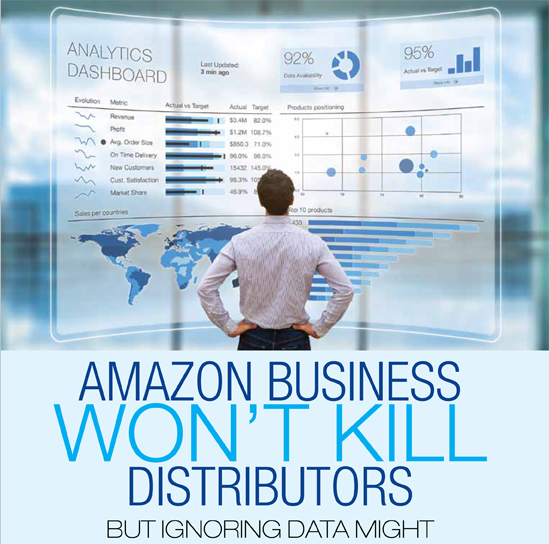Amazon Business Won't Kill Distributors

by Nelson Valderrama
By now you’re pretty familiar with these sayings: Netflix didn’t kill Blockbuster, ridiculous late fees did. Uber didn’t kill the taxi business, limited access and fare control did. Apple didn’t kill the music distribution business . . . well, OK, that one might be true.
In the next five, 10 or 15 years, many industrial distributors will claim that Amazon ruined their business. But just like Blockbuster, taxi companies and Tower Records before them, those distributors should really blame themselves.
So, what’s the real threat for distributors today? Making decisions without data.
New Blood Matters as Much as Your Core Customers
Last October, I participated in an e-commerce panel at the International Fasteners Expo where we asked participants how many had a website or e-commerce platform. Fewer than than 50 percent of them raised their hand. In my conversations with owners, they cited that they still have plenty of old-school customers calling, faxing and visiting their office who were the cornerstones of their business.
Now, as a 20-plus year veteran of this business, I know full well that relationships with partners who are stuck in their ways can be paramount, but at the risk of sounding ominous, those relationships only last as long as those partners.
Keeping your business growing for the long haul means finding new blood, and too few owners take the time to ask themselves how they are establishing and nurturing those relationships. To me, trying to succeed in a competitive environment where incremental business is not what it used to be is a losing proposition. We need to be relying on data to find that new blood.
Customers Are Speaking Clearly
During the expo, a gentleman approached me and asked for ideas on how he could optimize his operation. He told me that he could serve between 20 to 30 orders per day running his business in QuickBooks, and using a shopping cart hosted by Hostgator integrated into his system. His question for me was how to take the next step.
Why am I describing this man’s relatively basic IT setup?
Because while most readers of this article might have an ERP and/or CRM set up and probably have more infrastructure than this gentleman, I would bet good money that he has more success than most ahead. That’s because the challenge today is not technology. The challenge is to be open to listening to your customers’ behavior by using the data you have in your ERP and CRM — something he was eager to do!
By simply seeking out help digging into the data, he has a better chance to survive than many distributors that are running their business with monthly hard copy reports and no presence in the digital world no matter what their current market share.
We Aren’t Watching the Data
Most of the owners I talked with said they use reports to manage their business, which is better than nothing, but it is also kind of like driving a car using only the rear-view mirror. Let’s look at an example:
One of my favorite topics is pricing, so I often ask owners if they have a pricing strategy. All of them say yes (many try to show off and say it’s the secret sauce for their success). Then I ask how they execute that strategy. I get many answers and most are just guidelines about how the sales people follow certain target GM% and a minimum floor.
Then comes my favorite question: What report do you use to understand how pricing is working for your company? Most often I hear: “Um, I know my GM% is good” or “Well, we have a few reports we check but I suppose we could do better.”
We all know that pricing is one of the most powerful ways to improve your bottom line. Yet, for some reason, most distributors are simply not watching the data they have that could improve one of the most powerful levers they have to generate value.
Customers are screaming with their dollars and buying behavior and businesses are sitting with their heads in the sand.
The Art of Winning an Unfair Game
Sports fans know that statistics are everywhere. Baseball led the way, with quantitative tactics which you’ve probably heard about thanks to Michael Lewis’ book “The Art of Winning an Unfair Game (Moneyball)”. If you haven’t read it or seen the film adaptation, it focuses on the Oakland Athletics’ analytical, evidence-based approach to assembling a competitive baseball team, despite a disadvantaged financial situation (kind of like your company vs Amazon Business, right?)
A quote in the movie exemplifies the complexity of an industrial distributor trying to manage their pricing and understand what works.
Peter Brand: It’s about getting things down to one number. Using the stats the way we read them, we’ll find value in players that no one else can see. People are overlooked for a variety of biased reasons and perceived flaws. Age, appearance, personality. Bill James and mathematics cut straight through that. Of the 20,000 notable players for us to consider, I believe that there is a championship team of 25 people that we can afford, because everyone else in baseball undervalues them.
While I don’t think anyone believes that stats will replace coaches or managers in sports, we have seen numerous examples of teams proving that learning from data and using it on the field create competitive advantages. If you need more proof, just look at how the Golden State Warriors otherworldly second-half comebacks are actually driven by cold, hard data.
How to Become the Warriors on an Oakland A’s Budget
By now I hope some readers are starting to wonder how to find the team you need to win in 2019 among the 50 million “notable” combinations of pricing (1,000 customers, 10,000 products, five packaging quantities, etc.)
In November, we closed a couple of deals with mid-sized distributors by demonstrating how they could inch up their pricing by 200 bps (2%) and optimize their GM% with our SaaS application. One owner told us, “The analytics you’re providing is a dream come true because it means we don’t have to waste time on digging through the data/metrics gruntwork to find the low hanging fruit but I’m worried about how to integrate in our ERP system so all employees can use this in every quote.”
Like many in this industry, he understood the value of the output, but was hesitant to dive in because of the perceived complexity of a new and foreign business process.
That’s exactly why we created Intuilize: to simplify and shorten the process of transforming data into profits. After seeing the simplicity of the tool, the potential gains felt far more reachable to our client, as they should to any distributor who wants to drive real competitive advantages.
Bet Smart With Your Business By Using Real Data
Based on data from https://projects.fivethirtyeight.com, as of Nov. 8, there were 16 teams in the NFL and 21 NBA teams (including the Lakers) with less than a 1 percent chance to win the title in their respective leagues. If you were to place a bet, wouldn’t you rather have this data before placing your bet?
When it comes to betting on your business, the data is out there, you just have to know how to find it. Don’t find yourself blaming Amazon or competitors or your people for business decision failures. Start driving better decisions with the data you already have.
 Nelson Valderrama is CEO of Intuilize, a Software-as-a-Service platform that specializes in helping mid-sized distributors transform data into profits. With more than 22 years of experience as P&L manager and executive for major PE firms and industrial distributors, Nelson has dedicated his career to helping businesses uncover hidden competitive advantages and unleash the power of data. For more information or to learn more about using the data you already have to improve your bottom line, contact him by email at nelson@intuilize.com or visit www.intuilize.com.
Nelson Valderrama is CEO of Intuilize, a Software-as-a-Service platform that specializes in helping mid-sized distributors transform data into profits. With more than 22 years of experience as P&L manager and executive for major PE firms and industrial distributors, Nelson has dedicated his career to helping businesses uncover hidden competitive advantages and unleash the power of data. For more information or to learn more about using the data you already have to improve your bottom line, contact him by email at nelson@intuilize.com or visit www.intuilize.com.
This article originally appeared in the Jan./Feb. 2019 issue of Industrial Supply magazine. Copyright 2019, Direct Business Media.














